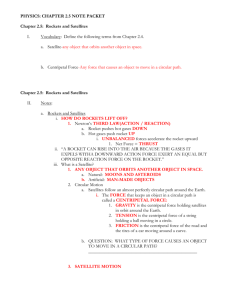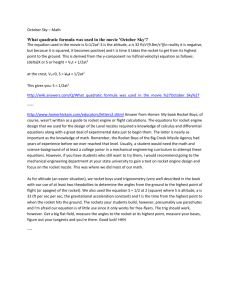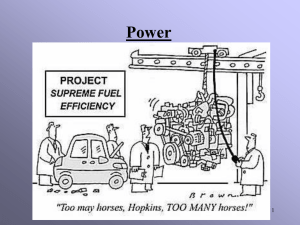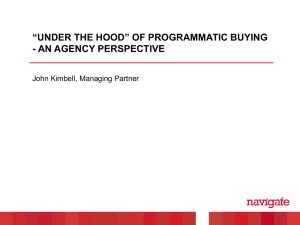SatDemoDoc2 - PhysicsLessons.com
advertisement
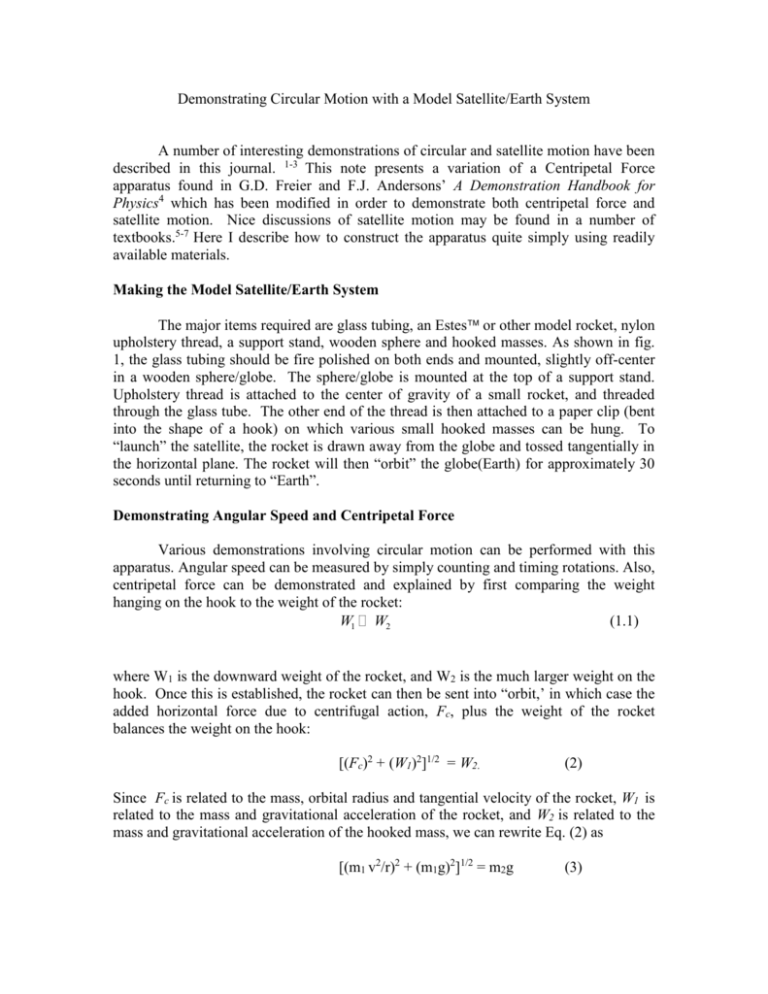
Demonstrating Circular Motion with a Model Satellite/Earth System A number of interesting demonstrations of circular and satellite motion have been described in this journal. 1-3 This note presents a variation of a Centripetal Force apparatus found in G.D. Freier and F.J. Andersons’ A Demonstration Handbook for Physics4 which has been modified in order to demonstrate both centripetal force and satellite motion. Nice discussions of satellite motion may be found in a number of textbooks.5-7 Here I describe how to construct the apparatus quite simply using readily available materials. Making the Model Satellite/Earth System The major items required are glass tubing, an Estes or other model rocket, nylon upholstery thread, a support stand, wooden sphere and hooked masses. As shown in fig. 1, the glass tubing should be fire polished on both ends and mounted, slightly off-center in a wooden sphere/globe. The sphere/globe is mounted at the top of a support stand. Upholstery thread is attached to the center of gravity of a small rocket, and threaded through the glass tube. The other end of the thread is then attached to a paper clip (bent into the shape of a hook) on which various small hooked masses can be hung. To “launch” the satellite, the rocket is drawn away from the globe and tossed tangentially in the horizontal plane. The rocket will then “orbit” the globe(Earth) for approximately 30 seconds until returning to “Earth”. Demonstrating Angular Speed and Centripetal Force Various demonstrations involving circular motion can be performed with this apparatus. Angular speed can be measured by simply counting and timing rotations. Also, centripetal force can be demonstrated and explained by first comparing the weight hanging on the hook to the weight of the rocket: (1.1) W1 W2 where W1 is the downward weight of the rocket, and W2 is the much larger weight on the hook. Once this is established, the rocket can then be sent into “orbit,’ in which case the added horizontal force due to centrifugal action, Fc, plus the weight of the rocket balances the weight on the hook: [(Fc)2 + (W1)2]1/2 = W2. (2) Since Fc is related to the mass, orbital radius and tangential velocity of the rocket, W1 is related to the mass and gravitational acceleration of the rocket, and W2 is related to the mass and gravitational acceleration of the hooked mass, we can rewrite Eq. (2) as [(m1 v2/r)2 + (m1g)2]1/2 = m2g (3) Where m1 is the mass of the rocket, v is the tangential orbital velocity of the rocket, r is the orbit radius, and m2 is the mass on the hook. To verify this relationship for the model, an experiment was performed in which v was obtained by measuring the radius of the rocket’s orbit with a meter stick, calculating the orbital circumference, 2r, and dividing that by the orbital time period, which was measured with a digital stopwatch. Velocity data from six trials were averaged and applied to equation 3. From the data it was found that the left-hand side of equation 3 agreed with the right hand side of equation 3 within 2.2 %. Given that the time period was measured by hand, measurement error likely accounted for the difference between the two values. Demonstrating Kepler’s Third Law During the rocket’s flight, the orbital radius decreases gradually until the rocket comes to rest back on “Earth”. Kepler’s third law, which can be expressed as T = 2r3/2/(GME)1/2 (4) Shows that the period of a satellite in circular orbit is proportional to the three-halves power of the orbital radius. To verify that this relationship holds true for the model, an experiment was performed in which the orbital time period was measured, using a digital stopwatch, at 5 different radii. The curve of best fit of time period versus radius, shown in figure 2 below, suggests the model closely approximates the relationship in Kepler’s third law. Figure 1. Satellite, globe, tube, thread and stand. References 1. John L. Makous, “Variations on a circular motion lab”, Phys. Teach. 38, 354-355 (Sept. 2000). 2. Bill Jameson, “Additions to a circular motion lab”, Phys. Teach. 37, 545-546 (Dec. 1999). 3. Knip, et. al., “Simulating realistic satellite orbits in the undergraduate classroom” Phys. Teach. 43, 452-455. (Oct. 2005) 4. G. D. Freier, F.J. Anderson, A Demonstration Handbook for Physics (American Association of Physics Teachers, Stony Brook, NY, 1981). 5. John D. Cutnell, Kenneth W. Johnson, Physics (John Wiley & Sons, Inc., Hoboken, NJ, 2004). 6. Paul W. Zitzewitz, Physics: Principles and Problems Glencoe/McGraw-Hill, Columbus, OH, 2002). 7. David Halliday, Robert Resnick, Jearl Walker, Fundamentals of Physics (John Wiley & Sons, Inc., Hoboken, NJ, 2004).


